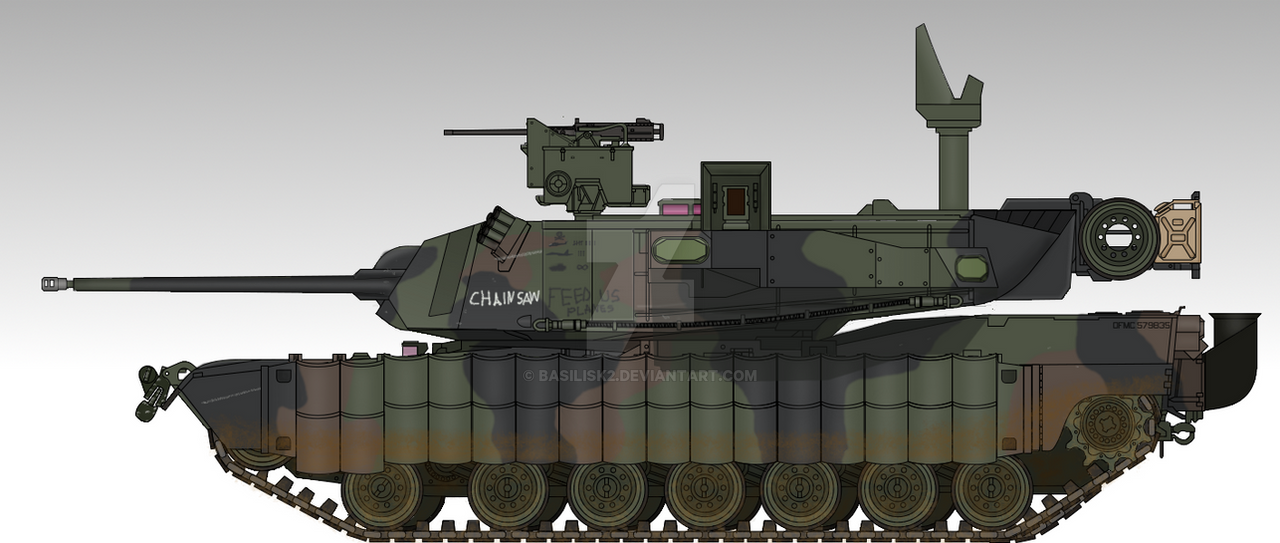HOME | DD
 Basilisk2 — AGDS 'Chainsaw'
Basilisk2 — AGDS 'Chainsaw'

#agds #shorad #abrams
Published: 2017-12-30 00:31:51 +0000 UTC; Views: 6519; Favourites: 84; Downloads: 0
Redirect to original
Description
The Air-Ground Defense System is a mobile SHORAD system developed from the M1A1 and M1A2 Abrams chassis to fill the gap in Osean Army and Marine Corps short range air defense caused by the shuttering of the DIVADS program and retirement of the M163 VADS and MIM-72 Chaparral, filling a secondary role as an anti-armor platform.The initial AGDS design, drafted in 1996, called for a combination of two Bushmaster III 35mm autocannons and 12 ADATS missiles, but the disappointing kinematic performance of the ADATS in the anti-air role and its excessive unit price led to a reassessment of the AGDS' armament. In place of the ADATS system, it was decided to use the RIM-116 Block 1 Rolling Airframe Missile, already in service with the Osean Maritime Defense Force. While RAM could not boast the impressive armor penetration afforded by the ADATS' large HE-FRAG warhead, anti-armor ability was determined to be secondary in priority to anti-air capability, and the RAM could effectively engage light vehicles with a software update anyway. Despite the longer armored launch box for RAM, the deletion of the large sensor array necessary for effective guidance of ADATS freed up a large amount of space in the turret, allowing electronics previously located in an electronics bay in the forward turret to be relocated to the space vacated by the ADATS optics. Additionally, the smaller diameter of RAM allowed more missiles to be carried, increasing the AGDS' basic load to 16 missiles as opposed to 12 with ADATS.
AGDS was intended to have as much commonality with the baseline Abrams as possible, with the relevant systems all being housed in the turret, which would be mated to an unmodified M1A2 or M1A1 hull, similar in philosophy to the Marksman system marketed by Marconi.
The AGDS came under fire in the budget cuts that accompanied the Osean military downsizing under the Harling administration, with administration officials questioning the necessity of such a large and complex platform in the era of peace that followed the Belkan War, when smaller, cheaper systems such as the LAV-AD and AN/TWQ-1 Avenger filled the same role at lower costs. However, OGDF and Marine Corps officials stood firm, citing the Bushmaster III's growth potential and the significant range advantage of RAM over the FIM-92 Stingers used by the LAV-AD and Avenger as vital capabilities for any future conflict. Their concerns were vindicated by the Usean Continental War of 2004-5, with FCU and ISAF forces being savaged by Erusian air attacks due to the inability of the Stinger to engage fixed wing aircraft before they were in weapons range.
The first AGDS units entered service with the Osean Ground Defense Force in 2008, with the Marines receiving theirs in 2009. OFMC AGDS tracks initially used surplus OGDF M1A1 hulls, being replaced by M1A2 hulls after the Circum-Pacific War.
The AGDS more than made up for its development costs during the Circum-Pacific War in 2010, effectively protecting OGDF and OFMC units from air attack, with its ability to keep pace with Osean armor formations being essential in the face of unreliable close air support as the Oseans progressed further inland. This lack of reliability also justified Army and Marine Corps concerns, proving OADF and OMDF aviation officers wrong in their statements during the AGDS' development that fixed wing aircraft would provide sufficient air superiority to preclude the need for a maneuver SHORAD solution.
However, the AGDS was not without its faults during the conflict. In the occasions when it did find itself engaging ground targets, the warhead on the RAM was found to be somewhat inadequate for destroying anything heavier than unarmored trucks and jeeps. As such, after the war a new development program was commenced, mating a warhead derived from the multi-purpose warhead of the AGM-114R Hellfire to the RAM airframe. The new missile was type classified MIM-116 Block 3 in 2014.
The AGDS continued to see heavy use in the years following its introduction, becoming an integral part of the Marine Air-Ground Task Force and the Armored Brigade Combat Team, supplemented in the Stryker Brigade Combat Teams and Light Armored Reconnaissance Battalions by Stryker-based SHORAD systems and LAV-AD/Avenger, respectively.
The AGDS pictured here, served with the Osean Federation Marine Corps 1st Marine Expeditionary Brigade 1st Light Anti-Air Battalion during combat operations in Bharat and Verusa in late 2024. The vehicle, nicknamed "Chainsaw" by its crew, sports prominent graffiti on the turret sponson electronics bay showcasing its kills.
The owners of the properties depicted herein and I maintain our respective rights.
Related content
Comments: 5

👍: 1 ⏩: 0

👍: 0 ⏩: 0

IT HUNGERS FOR YOUR PLANEFLESH
👍: 0 ⏩: 0

























